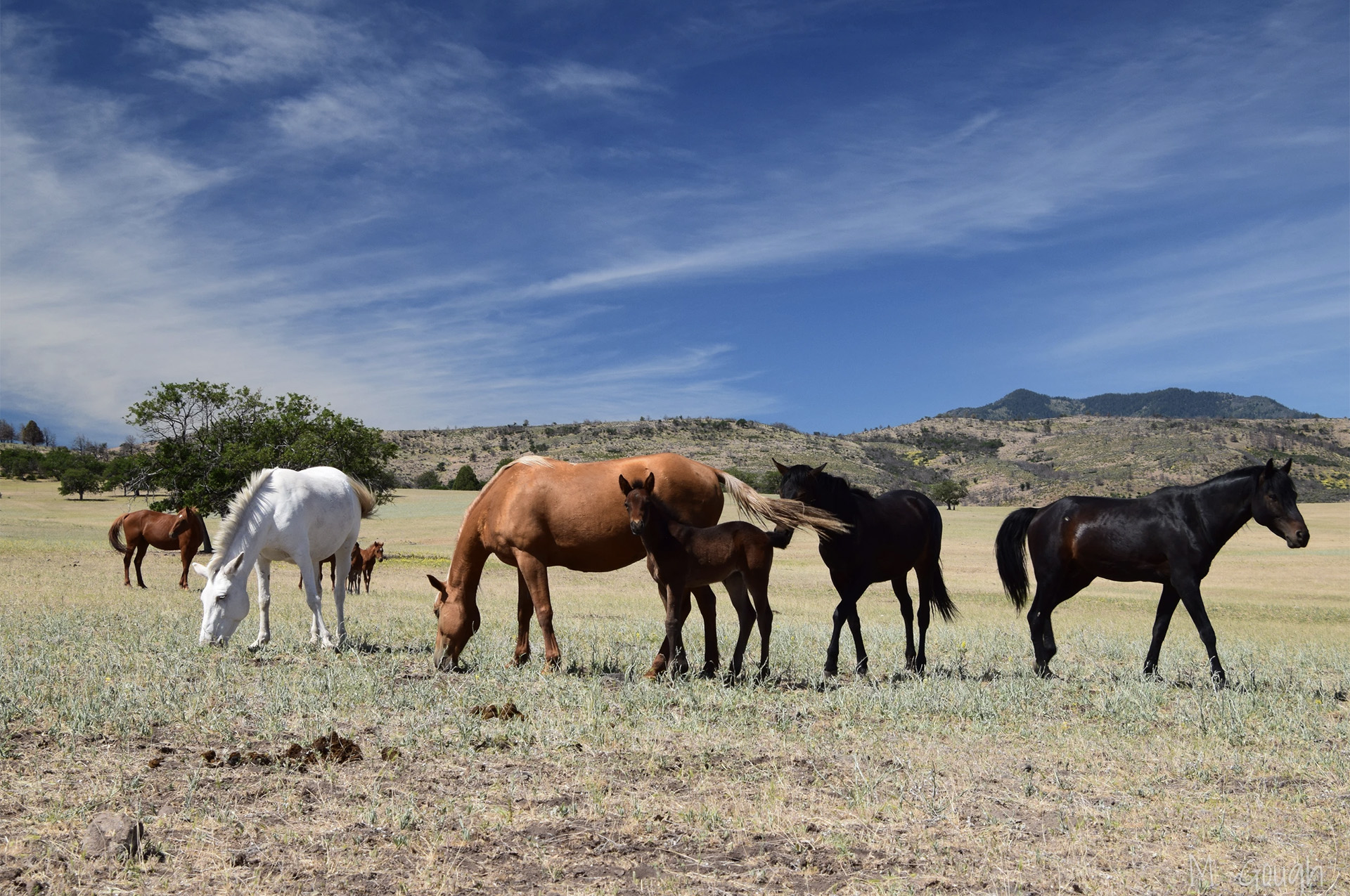By Cynthia Hubert
January 24, 2024
At a ranch in a remote portion of Siskiyou County, Sacramento State students Shelby Konarski and Cerys McLean spent part of their winter break studying a herd of wild horses that could play a key role in containing wildfires.
They are the first students to participate in a new Sac State internship program in partnership with the nonprofit Wild Horse Fire Brigade, which researches and manages a herd that the organization believes could help reduce catastrophic damages from wildfires.
Konarski, an Environmental Science major, and McLean, a Business student, spent two weeks studying the behavior and ecology of the horses as part of a project designed to demonstrate the positive impact of their grazing on rangelands.
“There is a natural way to manage these horses where everyone benefits,” said William E. Simpson, founder of the nonprofit group. “Instead of the federal government spending hundreds of millions of dollars rounding up wild horses and keeping them in holding pens and feeding them, why not put them to work reducing wildfire fields?”
California and other western states are debating how to manage the country’s wild horse population. Powerful livestock interests want the animals, which compete with cows for vegetation, removed from public lands and have supported roundups that opponents call cruel and unnecessary.
Simpson, who for more than a decade has lived among wild horses on a ranch near Yreka, says the solution is simple. He argues that the horses should be relocated to wilderness areas where they can play a critical role in preserving native flora and fauna while reducing grasses and brush that can contribute to wildfires.
“It was an amazing experience. Such a great opportunity to interact with horses in their natural environment. It gave us a great taste of what field research is all about.” -- Shelby Konarski, Sacramento State Environmental Science student
After Simpson approached Environmental Sciences Professor Wayne Linklater last year about a partnership, the University and the nonprofit agreed to collaborate on an internship program designed to benefit both students and the wild horse organization.
Students will help document the size and characteristics of Simpson’s free-roaming herd of over 100 horses and study their food sources and grazing habits. Later, they will assess the benefits of grazing on the rangeland, hoping to convince governments and livestock owners that the horses can be deployed for fire control.
Prescribed burns have long been used to reduce fuels that can feed wildfires, Linklater said, but the practice is controversial.
“This is a much more ecological approach to the issue,” he said. “These horses are providing an important service, and by demonstrating the benefits of horse grazing we can help maintain this species.”
Thousands of years ago, wild horses were abundant across the North American landscape, Linklater said, but they became extinct following the arrival of the first humans from Asia. Wild horses now are found primarily in the federal government’s “herd management areas” in western states.
“The elimination of wild herbivores, like horses, is part of the reason that wildfire risk has increased so dramatically,” he said.
Linklater said the horses “are the descendants of domestic animals that escaped or were released” and returned to a wild state.
Horses digest seeds less thoroughly than cows and goats, so their manure helps regenerate plants, preserving the landscape and helping mitigate wildfire risk, he added.

Konarski and McLean traveled to Wild Horse Ranch, near a wilderness area straddling the Oregon border, in December and January. For more than two weeks, they lived in a trailer home on the property and conducted field research within an area of about 100 acres.
Toting binoculars, a camera, GPS equipment, and a logbook, the women searched for the free-roaming horses, noting precisely where the animals gathered, herd sizes, coloring, and other characteristics.
Future interns will continue the population census and study grazing habits, food preferences, and scat. Later, Simpson and the students will conduct experiments to gauge whether the areas inhabited by the horses are less susceptible to wildfire damage.
“It was an amazing experience,” Konarski said. “Such a great opportunity to interact with horses in their natural environment. It gave us a great taste of what field research is all about.”
McLean, an IT expert, is working on a database of the horses. Konarski, who plans a career in environmental science, plans to return to Wild Horse Ranch in the spring and beyond to contribute to the research project.
“It’s something that I really believe in and have high hopes for,” Konarski said. “After spending time with these horses, I want to help as much as I can.”
Linklater said he hopes to send a steady stream of Sac State students to the area, which offers “extraordinary opportunities” for real-world experience in field research and education about the history and biology of wild horses.
“I’m excited to go back,” said Konarski. “I believe that if we give these horses the space to tend to the land, they will take very good care of it.”













